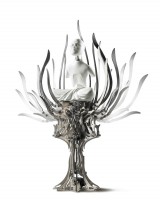WANG ZI WON
buddha z
source: obviousmagorg
O artista Ziwon Wang criou a série “Cibernética”, um conjunto de obras que retrata a presença e a influência da tecnologia nos dias de hoje, e como ela molda nosso estilo de vida.
Inspirado num pensamento que o próprio artista chama de “pós-humano”, a série de esculturas intrigam pelo intenso conceito por trás da arte.
O artista contrapôs os sentimentos humanos e a expressão serena e meditativa com elementos mecânicos desconexos, criando um espetáculo chocante para o espectador e ampliando, desse modo, a sensação de uma coexistência tumultuada entre a máquina e o homem. Confira aqui alguns dos seus trabalhos.
.
.
.
.
.
.
.
source: hanmigallerycouk
Ziwon WANG’s cybernetic sculptures poignantly address the ever increasing relationship between man and technology. The natural human features of Wang’s ‘post-human’ or ‘post-person’ sculptures with its serene and meditative expression are juxtaposed against the disjointed mechanical components, creating a jarring spectacle to the viewer. At the core of WANG’s works is the issue of decision making- the emotive human decisions against the coded and system judgments made by machines. Wang is concerned with the status of human thought and how it will transgress to the future. Wang’s interest in the manifestation and translation of the human decision making process in works of art through the passage of time can be found in the Buddha like poses which questions whether advancement of machinery and technology has, if any, changed the fundamental elements of human life.
The characteristic faces that are repeatedly found are in fact a self portrait of Wang himself. Wang’s combining of human features with the artificiality of the machinery are derived from the three stages of cybernetics. Wang is particularly interested in the stage of cyborg, of robots being able to take on roles of the human body such as artificial arms and legs to aid humans. Thus Wang is challenging of the often thought perception that the moral nature of human being are lost with the advancement of artificial intelligence.
Ziwon Wang graduated from Chungan University in Seoul, Korea with BA and MA in Sculpture in 2007. He was awarded the Song Eun Award in 2010 and selected for The National Art Studio residency programme 2011 in Korea. Wang’s works have been collected in many public collections such as the Seoul City Museum of Art and Incheon City’s Department of Finance, as well as co-operate instiutions as Art Bank Korea and Kolon Tower. Wang has exhibited in New York, Tokyo, Mumbai, Beijing, Hong Kong and Amsterdam.
.
.
.
.
.
.
.
source: julianhztumblr
These awesome mechanical figures are the work of South Korean artist Wang Zi Won, who designs and constructs “intricate mechanical figures of Buddha and bodhisattva that appear to be lost in meditation or enlightenment.”
The electrically-powered figures are fused with numerous mechanical components which at times resemble halos or lotus flowers and simultaneously move the humanoid figures through repetitive motions. The artist says his intention is to examine a future where humans and technology merge, something he views in a particularly positive light.
Head over to Colossal to learn more about Wang Zi Won’s incredible creations and watch a couple videos of them in action. These amazing automatons look like they’d fit right into some sort of futuristic biomechanical anime, so we’re delighted to learn that they really do move.
.
.
.
.
.
.
.
source: romokonblogspot
Wang Zi Won kibernetikus szobrai túl vannak minden emberin: személytelen kiberbuddhák és kiberbódhiszattvák. A tökéletes kiborg és a teljes felébredés, megvilágosodás egyaránt célja, terve az emberiségnek, bár két egymástól nagyon távoli szeletének. Elérni bármelyiket is szinte lehetetlen, mégis sokan törekednek rá fáradhatatlanul.


